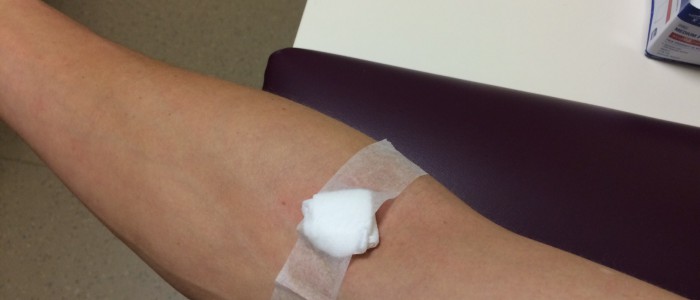Lipoprotein (a) [aka LP(a) or said, “L-P little a”]—is a useful albeit controversial blood test that is strongly associated with those who are at higher risk of heart attack and stroke. Simply, the higher the number beyond a threshold, the higher your risk that coronary arteries will collect plaques, a condition called atherosclerosis or arteriosclerosis. Furthermore, beyond the controversies about the pathogenesis or causative relationship to heart disease, LP(a) remains responsive to only some nutritional and drug agents. And to really confuse matters further, the nutrient niacin effectively lowers LP(a) but in a very well designed and executed study, displayed no reduction in heart attacks, strokes or atherosclerotic progress. [I won’t go into the details of LP(a) here, but if you want a detailed list of LP(a) info to chew on, start here.
OK, so why do I still want to see it? Because heart disease does not develop due to a single problem. I realize that drug ads have oversold the benefits of statins to doctors. Most doctors really believe that statins reduce the risk of heart attacks in higher risk individuals by over 50%…but they have fallen into the trap of relative risk compared to absolute risk. Meaning, that if 6 people have heart attacks in a ten year period in the “un-treated” group and only 3 have them in the “treated” group, that would be a 50% reduction of heart attacks. Or if you are a really good drug salesman you will say, “If you don’t take the treatment you are at double the risk.” Awesome right? But in my practice, in absolute terms, I have to treat one hundred people to reach those three. In other words, the drug fails to prevent heart attacks 97% of the time over that same period. So I’d better have a better way to measure who is at risk and who is not at risk and whether what someone is doing is working. We all need to use some measurements that go beyond the relatively poor results from the cholesterol-statin narrative.
This is why I use a “panel” of tests—one that offers a multiple risk insight. And most of these numbers can be modified through personalized nutrition, diet and fitness changes. If you have multiple results that are in the “higher risk” category and you move 5 markers into the “low risk or even the protected category, you add those improvements, so even if each improvement only lowers risk by 3-5%, 5 improvements makes for >20% measurable reduced risk. I am being conservative here, because if you do in fact have insulin resistance and sugar problems and you reverse that, your risk of heart disease reduces by >50% just with that improvement. Boom. Now you can measure the effective changes that occur with any change in diet, nutrition, fitness or changes in medications.
I am going to try to very simply explain why I have included each of these tests of the Blood Code Comprehensive Heart Disease Risk Panel. I’ll include my reason for each in a short couple of lines. If you spend time in the podcast universe you might think of a test that should be on here, but the goal is to have a wildly comprehensive panel that is less than $300. And this panel does it!
- Apolipoprotein A1 + B: Certain proteins metabolize the HDL and LDL in our body. Put simply, the A1 is healthier than the B therefore a low ratio is desirable. This is changeable with lifestyle.
- CBC (includes Differential and Platelets): High-normal WBC counts are associated with inflammation and heart disease
- Comprehensive Metabolic Panel (CMP): A basis of liver and glucose and kidney tests
- Ferritin: Genetically, 4-7% of the population stores and carries “too much” iron. This MUST be caught before it causes big inflammatory problems in the body.
- Fibrinogen Activity: This is a pro-clotting compound. Obviously high in active “thrombolytic events, but elevates with over-exercise. I have seen too many amateur athletes throw blood clots during training
- Hemoglobin A1c (HgbA1C): High blood sugar is the #1 cause of heart disease. Know that you have got this one good. Here is more
- Homocysteine: IF >10, it is “associated” With multiple conditions including cardio, and is correctable with common nutrients
- hs-CRP: Is there problematic inflammation or not? It is often absent!
- Insulin: This (HOMA-IR) catches the prediabetic pattern, called metabolic syndrome, before blood sugars rise: More here
- Lipid Panel with Ratios: I like the TG:HDL ratio even more than the Cholesterol and LDL #’s. More on that here
- Lipoprotein (A): A stand-alone risk factor, not enough to Cause heart disease, but can be additive to other risks
- Lipoprotein Fractionation, Ion Mobility: This is such a cool test, and used to be out of control expensive. Simply, small LDL cholesterol is more atherogenic than larger molecules. A healthy program should move you toward the larger LDL size.
- 25-Hydroxyvitamin D: Vitamin D – Low D raises heart disease risk, but high D can too. Like goldilocks, you want just right
- TSH: TSH is a thyroid hormone – but high normal levels are associated with atherosclerosis. This relationship is due to underlying blood sugar issues like insulin resistance.
- Vitamin B12 (Cobalamin): Low levels, below 400 should not be tolerated. Exhaustion and insomnia are results of low B12 and aggravate heart disease.
I love to help create algorithms to interpret lab results that steer you toward great health, but of course this is too challenging for some cases. Some of you might have a strong family medical history of heart attacks or strokes in non-smokers under 60 years of age, you may need some other stuff. Others might have naturally high cholesterol close to 300 mg/dL. In these cases, I advise more individualized care. I often order coronary calcium scores and other more specialized cardiac testing. I do some simple in-office tests too—Skinfold calipers, heart rate variability, grip strength, blood pressure and others.
Realize too that insurance is not really interested in preventing something that is ten years away. (the average job is held for <4 years now – even the employer does not really have your long term health in mind, it is truly up to you.) So these tests are typically not insurance-covered, which is why most doctors will not order them for you. Which is why I work to find the least costly way to get them done, and the online resource I link at the Blood Code provides test panels for about $200-300 that my local labs bill at about $1800-2400. I do not exaggerate.
If there are ever discounts available, I will work to inform my email list. In the meantime, here are the panels that I currently rely upon for The Blood Code, in my clinical practice and in my own life.




Comments are closed.